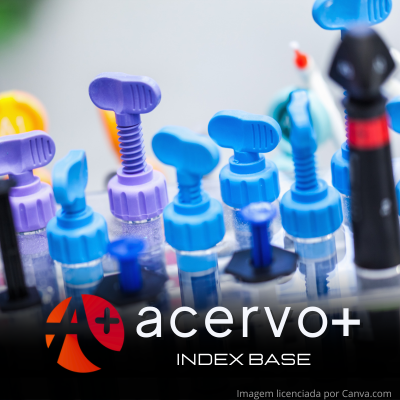Influência dos agentes modeladores nas propriedades da resina composta
##plugins.themes.bootstrap3.article.main##
Resumo
Objetivo: Avaliar a influência do uso de agentes modeladores para resinas compostas durante a técnica incremental nas propriedades de mudança de cor (∆E), microdureza e rugosidade superficial deste material. Métodos: A revisão está registrada no PROSPERO sob o número CRD42021238167. Foram selecionados estudos in vitro que avaliaram pelo menos as propriedades de cor de resinas compostas manipuladas com algum agente modelador, seja um líquido modelador ou um sistema adesivo. As buscas eletrônicas ocorreram no PubMed/MEDLINE, Scopus e Web of Science. Resultados: Foram obtidos 6.761 artigos, sendo seis selecionados de acordo com os critérios de elegibilidade. A alteração de cor foi reduzida com o uso do Adesivo Multi-Purpose Adper™ Scotchbond™ mesmo após armazenamento em vinho tinto por 6 meses (p = 0.00001; Diferença Média: -7.04; CI: -8.64 to -5.44) e por 12 meses (p = 0.00001; Diferença Média: -8.55; CI: -10.88 to -6.21), quando comparado ao grupo controle. Não foram observadas diferenças significativas na microdureza e rugosidade superficial com o uso de agentes modeladores em comparação ao grupo controle. Conclusão: A utilização de agentes modeladores com composição hidrofóbica para resina composta auxilia a manter a estabilidade da cor da restauração sem afetar a microdureza e rugosidade superficial.
##plugins.themes.bootstrap3.article.details##
Copyright © | Todos os direitos reservados.
A revista detém os direitos autorais exclusivos de publicação deste artigo nos termos da lei 9610/98.
Reprodução parcial
É livre o uso de partes do texto, figuras e questionário do artigo, sendo obrigatória a citação dos autores e revista.
Reprodução total
É expressamente proibida, devendo ser autorizada pela revista.
Referências
2. ASTUDILLO-RUBIO D, et al. Mechanical properties of provisional dental materials: A systematic review and meta-analysis. PLoS ONE. 2018; 13(2): e0193162.
3. BARCELLOS DC, et al. Effects of resinous monomers used in restorative dental modeling on the cohesive strength of composite resin. Journal of Adhesive Dentistry, 2008; 10(5): 351-4.
4. BARUTCIGIL Ç, YILDIZ M. Intrinsic and extrinsic discoloration of dimethacrylate and silorane based composites. Journal of Dentistry, 2012; 40 Suppl 1: e57-63.
5. COELHO-DE-SOUZA FH, et al. Direct anterior composite veneers in vital and non-vital teeth: a retrospective clinical evaluation. Journal of Dentistry, 2015; 43(11): 1330-6.
6. KARABELA MM e SIDERIDOU ID. Effect of the structure of silane coupling agent on sorption characteristics of solvents by dental resin-nanocomposites. Dental Materials, 2008; 24(12): 1631–9.
7. KIMMES NS. Commentary: the effect of a modeling resin and thermocycling on the surface hardness, roughness, and color of different resin composites. Journal of esthetic and restorative dentistry: official publication of the American Academy of Esthetic Dentistry ... [et al.], 2013; 25(6): 420–421.
8. KUTUK ZB, et al. Influence of modeling agents on the surface properties of an esthetic nano-hybrid composite. Restorative Dentistry Endodontics, 2020; 45(2): e13.
9. LOHBAUER U, et al. Factors involved in mechanical fatigue degradation of dental resin composites. Journal of Dental Research, 2013; 92(7): 584–91.
10. MÜNCHOW EA, et al. Use of dental adhesives as modeler liquid of resin composites. Dental Materials, 2016; 32(4): 570-7.
11. MUNCHOW EA, et al. Replacing HEMA with alternative dimethacrylates in dental adhesive systems: evaluation of polymerization kinetics and physicochemical properties. Journal of Adhesive Dentistry, 2014; 16(3): 221–8.
12. NAHSAN FP, et al. Clinical strategies for esthetic excellence in anterior tooth restorations: understanding color and composite resin selection. Journal of Applied Oral Science, 2012; 20:151-156.
13. PRODAN DA, et al. Influence of opacity on the color stability of a nanocomposite. Clinical Oral Investigations, 2015; 19(4): 867-875.
14. ROSA WL, et al. Bond strength of universal adhesives: A systematic review and meta-analysis. Journal of Dentistry, 2015; 43(7): 765-76.
15. SAMRA AP, et al. Color stability evaluation of aesthetic restorative materials. Brazilian Oral Research, 2008; 22(3): 205-10.
16. SARAFIANOU A, et al. Color stability and degree of cure of direct composite restoratives after accelerated aging. Operative Dentistry, 2007; 32(4): 406-11.
17. SEDREZ-PORTO JA, et al. Translucency and color stability of resin composite and dental adhesives as modeling liquids - A one-year evaluation. Brazilian Oral Research, 2017; 31: e54.
18. SEDREZ-PORTO, JM, et al. Effects of modeling liquid/resin and polishing on the color change of resin composite. Brazilian Oral Research, 2016; 30.
19. SIDERIDOU ID, et al. Physical properties of current dental nanohybrid and nanofill light-cured resin composites. Dental Materials, 2011; 27(6): 598–607.
20. TUNCER S, et al. The effect of a modeling resin and thermocycling on the surface hardness, roughness, and color of different resin composites. Journal of Estheticand Restorative Dentistry, 2013; 25(6): 404-19.
21. WOLFF D, et al. Recontouring teeth and closing diastemas with direct composite buildups: a clinical evaluation of survival and quality parameters. Journal of Dentistry, 2010; 38(12): 1001-9.

